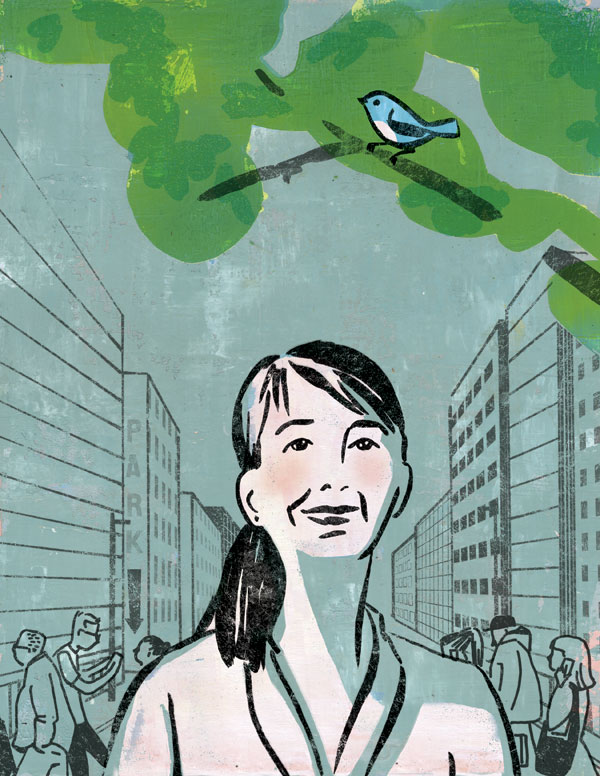During the years he was a hermit, Roger Cunningham followed a rigid and self-imposed daily schedule. He began the morning by walking to the nearby general store for coffee. “I had promised my mother that I would have regular contact with someone each day,” he says. “She was concerned I’d be too isolated.” Then, back in his hermitage, a farm near Nicholville, New York, he began 45 minutes of Zen meditation at 7:00. After breakfast, he worked alone in some of the 50 separate gardens that constitute his farm. Then came a lunch break, followed by more gardening. He maintained silence throughout, with no use of the phone, radio, or TV, which ensured, he says, that “everything I did was in the same frame of mind.” After dinner, he allowed himself some phone calls and blogging in the evening. The day ended for Cunningham with a final 45-minute session of meditation before bed. One day a week he devoted to work on the nonprofit organization he directed that distributed produce from his gardens to food banks in the area.
Across the country, Sister Laurel O’Neal, who is a member of the Camaldolese Benedictine order, follows a different hermit’s routine. She lives in a one-bedroom apartment in California’s populous Bay Area. She attends morning mass, sometimes runs errands in the afternoons, gives spiritual direction to clients in personal meetings, blogs, and plays violin in an orchestra every week. But most of her time, as someone officially designated a hermit by her order, she spends in contemplation and prayer.
Like Cunningham and O’Neal, many modern hermits—people who make the silence of solitude, and the spiritual contemplation it allows, a central part of their existence—seem determined to shatter our preconceptions of how hermits live. Many reside in or near towns and cities, support themselves with some kind of work, and mix at least occasionally with other people. Most importantly, they bear no resemblance to the misanthropes, survivalists, and social outcasts and failures we sometimes associate with hermit life.
On the contrary, today’s hermits lay claim to old spiritual traditions. Like early Chinese sages and medieval Christian monks who found enlightenment in solitude, modern hermits make time for assiduous prayer and lengthy spiritual contemplation. They have reclaimed the ancient Greek root of the word hermit—eremia, meaning desert, drawing from the experiences of Saint Anthony and other early Christians who discovered the divine in desert isolation. Nowadays few hermits live in the desert, but they hear the same siren call. “That call is so imperative you have little hope of ignoring it,” reports one solitary who wrote in Raven’s Bread, an internationally distributed newsletter for hermits. “But once embraced, there is true joy (after many inner battles) as you find your true center and heart’s desire.”
Cunningham, 59, came to a hermit’s life via the roundabout route that carried him through early retirement from a career as a social worker, a difficult divorce, the purchase of his farm in the Adirondack Mountains on a road that saw only about 10 cars a day and spent months under deep snow, and travels around the world. He then felt the urge to slow himself down, and he became a practitioner of the Zen style of meditation. The mindfulness that the practice of Zen Buddhism encourages drew him in. “I found I was leaving my farm less and less. I realized that what I was doing there was like what happens in a hermitage,” he recalls. “So I decided to formalize it and develop a rigid practice of meditation that demanded 12 hours of silence six days a week.” A new hermit was born.
What are modern hermits setting out to do? “Basically, nothing,” observe Karen and Paul Fredette, the publishers of Raven’s Bread, in a book they’ve written about hermitic life. “Nothing unusual, that is. Hermits live ordinary lives but with an extraordinary motivation.”
Several years ago the Fredettes surveyed their Raven’s Bread readers—who now number more than 1,500—to discover trends and similarities in their lives. “These people live the majority of their time alone. They treasure silence in solitude,” Karen Fredette notes. The survey’s findings from 122 responses: 60 percent were women; the respondents came from a mix of Catholic, Protestant, Hindu, Sufi, and Buddhist religious backgrounds; and most were middle-aged or older. “You can do it in an apartment in New York City, and some of our readers do, or in the suburbs. Most prefer not to be known as hermits, and their outward appearance does not draw attention,” she says. “Some live in groups and support one another by gathering together once a week, but they live in solitude most of the time.” Others maintain a hermitic life while caring for older relatives, or even while married.
Cunningham says he treasured his silent hours of solitude as a hermit, “when I became totally aware of my oneness with the world and never felt detached from my surroundings. I believe that the common way of thinking of myself as a separated individual identity, disconnected from what’s all around me, is an illusion. It takes me down a road toward suffering. The only way for me to see the illusion was to join myself with the birds, and nature, and my surroundings, with no separation. Turning over my farm’s soil, becoming mindful of the textures of the soil, hearing the birds, seeing the trees, and feeling the wind and perspiration on my cheek—it all put me in the present, the here and now, which I recognized was the whole point of my Zen practice. ”
It’s an old impulse. “Most of the luxuries, and many of the so-called comforts of life, are not only not indispensable, but positive hindrances to the elevation of mankind,” wrote Henry David Thoreau, one of America’s best-known seekers of solitude, in the 19th century. Living in the 1840s in a cabin he built on Walden Pond in Massachusetts, Thoreau maintained his close ties with family and friends as he made time to be alone and study his place in the natural world. “Not till we are lost, in other words, not till we have lost the world, do we begin to find ourselves and realize where we are and the infinite extent of our relations,” he wrote. He believed he could emerge from his two-year solitude “a more perfect creature, fitted for a higher society.”
Thoreau physically distanced himself from society, but many contemporary hermits do not. “Living separate from society doesn’t mean never seeing anybody,” Fredette, herself a former hermit, explains. “On the other hand, having a TV running all day is not helpful to the hermit life. It involves wanting a simplicity of life, and it demands self-discipline and a positive self-image. When you’re living alone, there’s only one person to deal with all day, so you’d better like yourself.”
Become a Saturday Evening Post member and enjoy unlimited access. Subscribe now




